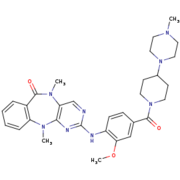User:Estelle Metzger/Sandbox
From Proteopedia
(Difference between revisions)
| Line 22: | Line 22: | ||
In most kinases, there is a mechanism to switch from an inactive to an active state. | In most kinases, there is a mechanism to switch from an inactive to an active state. | ||
| - | This involves autophosphorylation of some residues in the activation loop. . Autophosphorylation not only results in the reorientation of the activation loop, but often also alters ATP binding and/or interaction with substrates.<ref name="Huse"/><ref name="Taylor"/> In Roco4 kinase, there are four phosphorylation sites in the activation loop : Ser1181, Ser1184, Ser1187, and Ser1189.<ref name="Bernd"/> | + | This involves autophosphorylation of some residues in the activation loop. . Autophosphorylation not only results in the reorientation of the activation loop, but often also alters ATP binding and/or interaction with substrates.<ref name="Huse"/><ref name="Taylor"/> In Roco4 kinase, there are four phosphorylation sites in the activation loop : Ser1181, Ser1184, Ser1187, and Ser1189.<ref name="Bernd"/><ref name="Mills"/> |
The structure of ''Dictyostelium'' Roco4 kinase in complex with the LRRK2 inhibitor H1152 allows us to see that Roco4 and other Roco family proteins are essential for the optimization of the current, and identification of new LRRK2 kinase inhibitor. To have a Roco4 protein which have an active site resembling human LRRK2, researchers use a ''Dictyostelium'' Roco4 mutant (<scene name='75/751216/1107/1'>TF1107L</scene> and <scene name='75/751216/1161/1'>TF1161L</scene>) which is called humanized Roco4.<ref name="Bernd"/> | The structure of ''Dictyostelium'' Roco4 kinase in complex with the LRRK2 inhibitor H1152 allows us to see that Roco4 and other Roco family proteins are essential for the optimization of the current, and identification of new LRRK2 kinase inhibitor. To have a Roco4 protein which have an active site resembling human LRRK2, researchers use a ''Dictyostelium'' Roco4 mutant (<scene name='75/751216/1107/1'>TF1107L</scene> and <scene name='75/751216/1161/1'>TF1161L</scene>) which is called humanized Roco4.<ref name="Bernd"/> | ||
Revision as of 08:50, 27 January 2017
Humanized Roco4 bound to LRRK2-IN-1
| |||||||||||
References
- ↑ 1.0 1.1 1.2 1.3 Gilsbach BK, Ho FY, Vetter IR, van Haastert PJ, Wittinghofer A, Kortholt A. Roco kinase structures give insights into the mechanism of Parkinson disease-related leucine-rich-repeat kinase 2 mutations. Proc Natl Acad Sci U S A. 2012 Jun 11. PMID:22689969 doi:10.1073/pnas.1203223109
- ↑ 2.00 2.01 2.02 2.03 2.04 2.05 2.06 2.07 2.08 2.09 2.10 Gilsbach BK, Messias AC, Ito G, Sattler M, Alessi DR, Wittinghofer A, Kortholt A. Structural Characterization of LRRK2 Inhibitors. J Med Chem. 2015 May 1. PMID:25897865 doi:http://dx.doi.org/10.1021/jm5018779
- ↑ 3.0 3.1 3.2 3.3 3.4 Gilsbach BK, Kortholt A. Structural biology of the LRRK2 GTPase and kinase domains: implications for regulation. Front Mol Neurosci. 2014 May 5;7:32. doi: 10.3389/fnmol.2014.00032. eCollection, 2014. PMID:24847205 doi:http://dx.doi.org/10.3389/fnmol.2014.00032
- ↑ 4.0 4.1 4.2 4.3 4.4 4.5 4.6 Mills RD, Mulhern TD, Liu F, Culvenor JG, Cheng HC. Prediction of the repeat domain structures and impact of parkinsonism-associated variations on structure and function of all functional domains of leucine-rich repeat kinase 2 (LRRK2). Hum Mutat. 2014 Apr;35(4):395-412. doi: 10.1002/humu.22515. Epub 2014 Feb 24. PMID:24470158 doi:http://dx.doi.org/10.1002/humu.22515
- ↑ 5.0 5.1 doi: https://dx.doi.org/10.1016/S0092-8674(02)00741-9
- ↑ 6.0 6.1 Taylor SS, Kornev AP. Protein kinases: evolution of dynamic regulatory proteins. Trends Biochem Sci. 2011 Feb;36(2):65-77. doi: 10.1016/j.tibs.2010.09.006. Epub, 2010 Oct 23. PMID:20971646 doi:10.1016/j.tibs.2010.09.006
- ↑ [1], Retrieved on January 27th 2017.
- ↑ 8.0 8.1 UniProtKB - Q5S007 (LRRK2_HUMAN), Retrieved on January 27th 2017.


